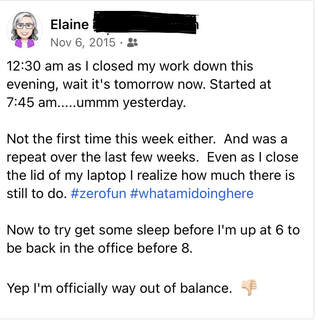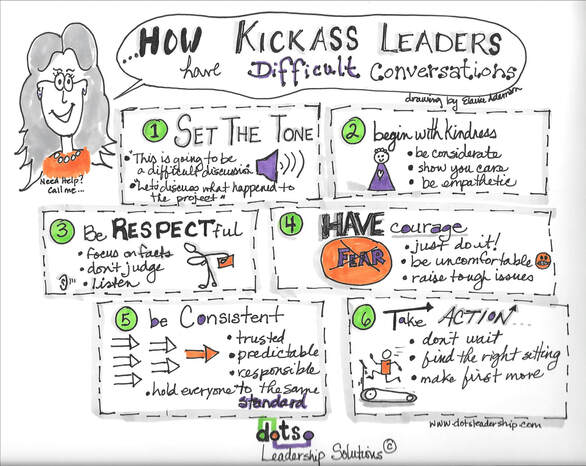Words Have ImpactWhat you say, really matters to your team. I've said it before, employees are always watching. The tone you use is important, but what you actually say can reverberate...for years!!
‘You have no idea how long something you say can stay inside someone’s mind!’ I read that quote recently and it reminded me how important it is to be mindful of my words, particularly with those who work with me. Words can lift people up or - break them down. A leader or manager's words can have such a lasting affect, especially the critical ones. Here is a great leadership book for more great tips - The Leader's Voice by Clarke & Crossland. When I reflect on comments that sit with me ‘You use unsophisticated language’, and ‘You’re intimidating’ are the ones that still ruminate for me from leaders I reported to decades ago!!! Ugggh. I'd like to erase them but they still remain in my head and they make me question my approach with clients.
0 Comments
My Dad had a triple bypass at age 45 so you can imagine what I was thinking.; it messed with my head. The doc insisted I take a minimum of two weeks off with absolutely no work. I went to a clinic the next day for a heart stress test and sent home with a holter monitor (heart and blood pressure thing)
Something happens to you when you have a health scare and realize it's been cause by the work that you hate doing. You immediately start taking stock and assess what steps you need to take to make it stop. Leading Change is HardClients often ask how much time and effort is enough to lead people through a change initiative?
My answer: as long as it takes to help your people through it. I have to let them know the truth, that unfortunately, you can’t anticipate how long it will take for individual people to get to acceptance. We are all different. The reality is, we all move along the change curve at our own individual pace. Just like grief, you can't help someone get through it faster. That said, there are things you can do to help people find their way. Are you hiding the real you from work?
Can you sing? Play the trumpet? Do you bake pies? Do you laugh with your full belly? Do you snort!? Do you paint watercolour or absolutely love to garden? Do you love hip hop or can you rap? How many on your team know who you really are? Does anyone? Sadly many of us hide our full self from work, or worse….from our teams. We so often buy into this notion that we have to fit a particular stereotype to be a successful leader - it is all business, all the time. When I worked in corporate, there was an executive that wasn’t particularly liked. In fact we had many complaints about her behaviour in HR. She was an ice queen. She was ‘perfect’. She hit every deliverable out of the park, and then some. But man, she pushed her people hard! With Power Comes Great ResponsibilityMy hubby and I have this ongoing joke that I am a closet cape crusader. You see I stand up for good vs. evil and I even have recurring dreams where I leap out of my car to rescue someone from a car accident. Did you ever think of yourself as a super hero? Well I’m here to tell you, that just like every defender of the universe has unique powers, so do you!
All business leaders I’ve worked with have powerful influence over others as well as many other admirable traits. The fact is that each and every people leader brings special powers to the world; it just hasn’t been pointed out in that way! How To Get A PromotionEver wonder how your company’s President or senior decision makers decide on who to promote? Well, I’m going to reveal it to you today.
...It doesn’t have anything to do with how many additional hours you put in. ...It has no relation to how many lunch breaks you skip. ...And your late night email response rate has absolutely no bearing on the decision. It’s all about HOW you show up! Senior executive leaders are listening carefully to those reporting to them and are observing who gets acknowledged most frequently – and yes, HR partners are also providing them with insights regarding HOW people situations have been dealt with. Senior Execs are always on the lookout for future leaders who can make a positive impact. Of course the unique keys to being promotable may differ slightly from one organization to the next, but there are many elements that senior teams everywhere look at to determine who stands out above the rest. So, how do you get noticed in a sea of people? Let me share a few HR secrets for how to demonstrate YOU are the one to watch: Find Hidden ResourcesAre you under constraints at work and it’s taking a toll on you as the leader? Do you have more work to do but no additional headcount? Perhaps there is a hiring freeze or you’ve been told you can’t bring in replacements when someone leaves your unit.
Unfortunately, this is how a lot of big companies deal with shrinking market share or downturns in their industry. But what if I told you there might be some resources available that you can’t see yet? In fact, you may be able to recoup a full role or parts of a role, you just need to know where and how to look... How to Deal With Work StressThese days everyone is putting in longer hours, but not feeling as fulfilled as they would like to. It’s almost as if you’re on a treadmill that is increasing in speed with no destination!
“Work” definition – according to the Oxford Dictionary is the activity involving mental or physical effort done in order to achieve a purpose or result; as a means of earning income. So, we know that effort of any type can tire you out, but when you lack balance in that effort it can lead to chronic stress and tension. According to the National Institute of Mental Health, chronic stress lowers your immune; it also lowers your digestive and reproductive systems. It affects your ability to sleep and is said to be a silent killer. So how do you regain personal balance to prevent burnout and chronic stress? How Do You Build Your Team?Updated: February 2021
Most corporate team off sites (done onsite in the boardroom with food catered), are done with the intent of having a team building experience. You know what I’m talking about? One of those meeting when the team gets together away from their usual desks. A caterer brings in two Diet Cokes and three cans of Sprite for a team of 7. The food is the same each time, usually some kind of sandwiches, and the last person to select gets stuck with the egg salad. For team building you might add an exercise or two like “If you were an animal, what kind would you be and why”. With a few laughs and full tummies do you really expect your team to be more successful? Unfortunately these team building activities seldom generate success behaviours. Management may think team building happens when they invest in a few meals together, but the reality is your team just hopes for an early exit home. Seldom does the 'building' of a team really occur. How To Have Difficult ConversationsI was delighted when Kim Scott's book Radical Candor came out as I heartily share her views on candid conversations. To me it really is an art, not a science! Just like art, you improved the more often you do it. While there may be steps to take, you only develop comfort for 'uncomfortable discourse' as you practice doing it. I'm not telling you it will be easy. After all, it does go against with what your Momma taught you - 'if you don’t have anything nice to say, don’t say anything at all'. But when you become a leader (just as Kim says) ' it’s your job to speak up--so it's your obligation to be candid'. Do Your Employees Hate Work?When great employees don’t get what they need to thrive, they wither and become a zombie before your eyes.
Has your previously amazing rock star employee turned into one of the ‘working dead’..... that quit, but stayed? How would you know if you have disengaged employees? Sometimes, it is not very obvious. Zombie employees may get sick frequently; they may complain or stew about issues more; they are more detached; they increase the number of breaks or take a long time to accomplish work; or, they seem more frustrated or annoyed. When team members, who were previously quite involved and full of life, become quiet or just don't bother trying anymore - there is a good chance they're checking out. It is becoming quite an epidemic. According to Gallup less than 13% of employees are an engaged worldwide – that means many people hate their jobs. With a concerted effort you can bring them back from the brink while preventing the further demise of your very best people. Will Your Team Follow YOU?Updated April 2020
“Let’s play follow the leader Nanni,” my 3-year old grandson says, pulling on my hand. He leads me through the house, taking me downstairs and back upstairs. We crawl, we jump and we stand still; he laughs when I shadow him and is so delighted I’m following his lead. He then says, “Nanni its your turn to be the leader!” After much laughter, we fall into a heap on the couch. Fun and shenanigans like this make for some great memories. Too bad leading a team isn’t quite that straightforward – or is it? Rebuild Team Trust After LayoffsSo your team has been restructured and the dust finally settled.
Now, you’re supposed to go back to ‘business as usual’ but things feel far from normal. As the leader, you’re in a tough position because everyone on your team turns to you for answers and clarity. But, you're as much in the dark as they are, maybe a bit ticked off too....so what do you do? Rest assured you’re not alone; heck, you can’t read a newspaper or hear a business report these days without learning about a company cutting back, laying off or reorganizing. Just like you, there are hundreds of leaders trying to find their way to get back on track, regrouping but also trying to rebuild trust of the ‘survivors’. Poor Communication = No ConnectionThese days, with all the tools we have available, we are far more connected and capable of staying in touch than ever before!
So don’t you find it a bit ironic that in today’s workplaces, lack of communication remains one of the biggest issues for employees? Regardless of the industry or size of company! Here’s the thing - if your team doesn’t feel heard, they don’t understand the direction of the company, never get constructive feedback, or they don’t think you care about them as a person, then why would they give you their best work? Self-Doubt is DebilitatingTrue story - 20 years ago I didn’t feel worthy of a $25,000.00 salary!
After 9 years of raising our daughters, I began the difficult task to return to the workforce, was turned down for every job I applied to and told my skills were ‘out-of-date’. It felt horrible to be rejected, but what was worse was how I felt about myself. I remember sobbing to my husband ‘Who will ever pay ME $25,000 (the going rate) after being out of the workforce; all I am is a stay-at-home Mom!’ |
Most Popular Posts:
AuthorElaine Adamson is a leadership consultant with Dots Leadership Solutions Inc. A natural dot connector. Passionate about coaching team effectiveness and leadership development she shares over 25+ years of real-life tips and tricks that really work! 
Elaine believes you can discover and leverage strengths to forge a strong team dynamic despite business challenges or organizational change.
She posts some great articles on Linked In too! Topics of Interest
All
Archives By Date
November 2022
|
Specialties |
Company |
|

















 RSS Feed
RSS Feed